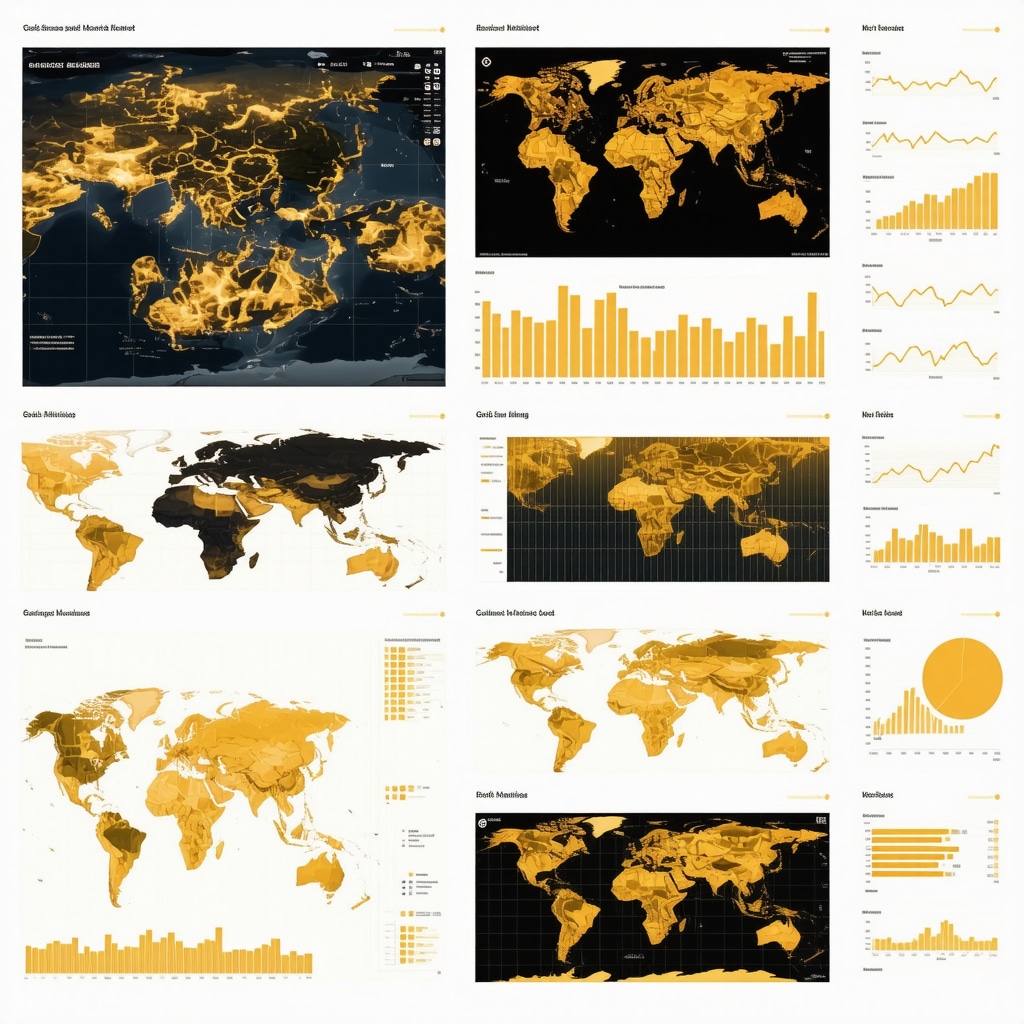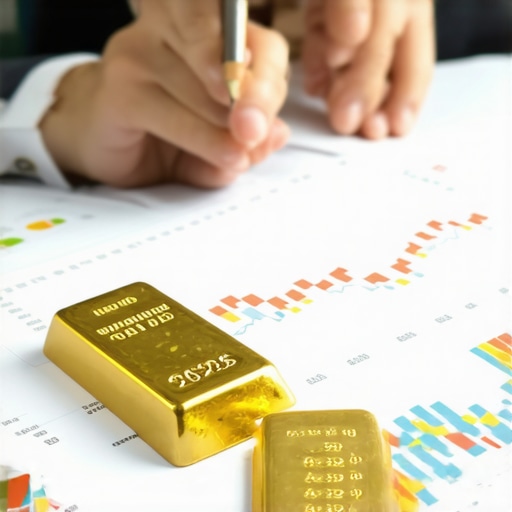Unlocking the Secrets Behind Gold’s Market Pulse
Gold has long captivated investors with its timeless allure and reputation as a safe haven. Yet, beneath the glittering surface lies a complex interplay of supply and demand forces shaping its price trajectory. Understanding these dynamics is essential for smart investing, especially in 2025’s evolving economic landscape where geopolitical tensions, inflationary pressures, and technological shifts converge.
Mining Realities: How Gold Supply Constraints Shape Investment Opportunities
Gold supply originates primarily from mining production and recycled sources. However, mining output is subject to geological limitations, regulatory hurdles, and escalating extraction costs. For example, the average grade of gold ore has declined over decades, demanding more energy and advanced technology to maintain supply levels. This natural scarcity underpins gold’s intrinsic value and often causes supply-side shocks that can spark price surges.
Moreover, central banks continue to play a pivotal role by adjusting their gold reserves, influencing available market supply. Understanding mining trends and central bank activities offers investors foresight into potential supply squeezes that can enhance returns.
Diving Into Demand: Unraveling Gold’s Diverse Buyer Landscape
Demand for gold is multifaceted, spanning jewelry fabrication, industrial applications, investment vehicles, and sovereign reserves. Jewelry remains the largest consumer segment globally, especially in emerging markets like India and China. Yet, investment demand via exchange-traded funds (ETFs), mutual funds, and physical bullion has surged dramatically, reflecting gold’s role as a hedge against inflation and market uncertainty.
Technological advancements also drive a nuanced industrial demand in electronics and medical devices, albeit a smaller fraction compared to investment and jewelry. Tracking shifts in consumer preferences and financial market trends is crucial for anticipating demand-driven price movements.
How Do Supply and Demand Fluctuations Affect Gold Prices in the Short and Long Term?
Short-term gold prices are often volatile, reacting to immediate supply disruptions or spikes in investment demand triggered by geopolitical crises or economic data releases. For instance, during periods of inflationary anxiety, investors flock to gold as a safe asset, pushing prices upward.
Conversely, long-term price trends hinge on persistent supply constraints from mining coupled with sustained demand growth from developing economies and financial markets. An insightful example is the tightening supply amid declining mine grades, juxtaposed with rising ETF holdings that have reached record levels globally.
Investors must therefore balance these temporal factors, considering macroeconomic indicators alongside mining reports and demand forecasts to navigate gold’s price cycles effectively.
Integrating Gold Supply and Demand Insights into Your Investment Strategy
Leveraging a deep understanding of gold supply and demand equips investors to make informed decisions. Diversifying across physical gold, ETFs, and mutual funds can mitigate risks linked to supply shocks or shifting demand patterns. For practical guidance on investment vehicles, explore our detailed analysis on comparing gold mutual funds and ETFs.
Additionally, staying informed about central bank policies, mining innovations, and consumer trends is vital for anticipating market shifts. Resources like the World Gold Council provide authoritative data and analysis to support strategic decision-making.
For those interested in mastering gold trading dynamics, our comprehensive insights on effective gold trading techniques can enhance your market agility.
Feel free to share your thoughts or experiences on gold investing in the comments below. Your insights contribute to a richer community understanding of this enduring asset.
For further reading on how gold’s supply-demand dynamics impact prices, consult the World Gold Council’s comprehensive reports at gold.org.
Reflecting on the Human Element Behind Gold’s Demand
One aspect that often gets overlooked in discussions about gold’s market dynamics is the deeply personal and cultural connection people have with gold. I remember traveling through India and witnessing firsthand how gold jewelry isn’t just adornment but a symbol of tradition, status, and security. This emotional attachment fuels consistent demand, especially in regions where gold is intertwined with weddings and festivals. That cultural demand can sometimes insulate gold prices from pure economic logic, adding a fascinating layer to market analysis.
Moreover, central banks’ strategic moves—like the recent increases in gold reserves by countries such as China and Russia—reflect a sovereign desire to hedge against currency volatility and geopolitical risks. These moves, reported by the World Gold Council, have tangible ripple effects on global supply-demand balances (source: gold.org).
My Approach to Balancing Physical Gold and Paper Investments
When I first started investing in gold, I was torn between buying physical bars and coins versus investing in gold ETFs and mutual funds. The tactile satisfaction of holding physical gold is unmatched; it feels like owning a piece of history and security. However, I learned that physical gold requires secure storage and vigilance against fraud, which can be daunting for newcomers. In contrast, gold ETFs and mutual funds offer liquidity and ease of diversification but lack the tangible aspect.
I found that a balanced portfolio incorporating both physical gold and paper gold instruments provides flexibility and resilience. For anyone curious about this balance, our guide on comparing gold mutual funds and ETFs offers practical insights to help you decide based on your goals and risk tolerance.
Have You Ever Wondered How Geopolitical Events Shape Your Gold Investment?
Gold’s price often spikes during geopolitical crises, but how exactly do these events influence your investment decisions? From personal experience, I recall the sudden surge in gold prices during a regional conflict a few years ago. It made me realize that staying informed on global affairs is not just for general knowledge but crucial for timely portfolio adjustments.
If you have stories or strategies on how geopolitical shifts have affected your gold investments, I’d love to hear them. Sharing experiences can enrich our collective understanding and preparedness.
For those interested in deepening their market knowledge, exploring 2025 gold market trends and analysis can provide valuable context and forecasts.
Engage in the conversation by leaving a comment below or sharing this article with fellow investors who value gold’s enduring role in wealth preservation.
Decoding the Impact of Emerging Technologies on Gold Supply and Demand Dynamics
As we forge deeper into the 21st century, technological innovation is reshaping every facet of the gold market—particularly in how supply and demand evolve. Beyond traditional mining, advancements in extraction techniques such as bioleaching and automation are gradually enhancing yield efficiency, potentially alleviating some supply constraints. However, these technologies come with steep capital costs and regulatory scrutiny, which may temper their widespread adoption in the near term.
On the demand front, the rise of cutting-edge applications in electronics, medical devices, and even nanotechnology is subtly but steadily increasing industrial gold consumption. For instance, gold’s unparalleled conductivity and biocompatibility make it indispensable for implantable medical sensors and flexible electronics, sectors experiencing robust growth. These nuanced industrial demands add layers of complexity when forecasting gold’s price trajectory since they are less visible than investment or jewelry purchases but exert cumulative pressure over time.
How Do Technological Innovations Alter Gold’s Supply Security and Price Stability?
Technological breakthroughs in mining and recycling could theoretically bolster gold supply security, mitigating the volatility caused by traditional geological and geopolitical risks. However, the adoption curve for these innovations is uneven globally, influenced by factors like infrastructure, skilled labor availability, and policy frameworks. As a result, while technology promises enhanced supply stability, its real-world impact on price stability remains a dynamic and regionally differentiated phenomenon.
Moreover, the integration of blockchain for provenance verification is transforming gold trading by enhancing transparency and reducing fraud risk. This innovation, supported by initiatives such as the Responsible Gold Mining Principles, also appeals to ethically conscious investors, potentially shifting demand patterns toward certified gold sources.
Understanding these technological shifts helps investors anticipate supply-side adjustments and evolving demand preferences, allowing for more precise positioning within gold markets.
Geopolitical Chessboard: Assessing Gold’s Role Amid Global Power Realignments
Gold’s function as a geopolitical hedge has never been more pronounced. In an era marked by rising multipolar tensions, trade wars, and currency fluctuations, sovereign entities and institutional investors increasingly view gold as a strategic asset to diversify their reserves and buffer against systemic shocks.
Recent moves by central banks of emerging economies to accumulate gold reserves reflect this strategic calculus. For example, the International Monetary Fund’s data reveals that nations like India, Turkey, and Kazakhstan have augmented their gold holdings significantly in the past five years, signaling efforts to reduce dependence on the US dollar and fortify financial sovereignty (IMF Data Portal).
Such central bank behaviors intertwine deeply with geopolitical narratives, influencing gold’s liquidity and pricing mechanisms globally. Investors attuned to these macro-political undercurrents can better navigate periods of heightened uncertainty.
What Strategies Can Investors Employ to Hedge Against Geopolitical Risks Using Gold?
Investors aiming to leverage gold as a geopolitical hedge should consider diversification across physical bullion, ETFs, and sovereign gold bonds to balance liquidity, security, and yield. Timing entry points around geopolitical events requires vigilance and a nuanced understanding of the event’s scope and potential market repercussions.
Moreover, layering gold investments with other non-correlated assets can amplify portfolio resilience. Employing data-driven analysis and geopolitical intelligence sources enhances decision-making precision in this volatile arena.
The Intricacies of Central Bank Gold Policies: Beyond Simple Accumulation
Central bank gold policies are no longer straightforward accumulation strategies; they are sophisticated tools of monetary policy and geopolitical signaling. The interplay between gold purchases, sales, leasing, and collateralization affects global supply-demand equilibrium in subtle yet impactful ways.
For instance, gold leasing programs—where central banks lend gold to bullion banks—inject short-term supply into markets but can create latent supply risks if not managed prudently. Likewise, the repatriation of gold reserves, as seen in Germany’s Bundesbank initiatives, alters domestic versus international gold availability, influencing pricing dynamics.
Understanding these mechanisms is essential for investors seeking to interpret market signals accurately and anticipate shifts driven by central bank behavior.
For a deep dive into central bank gold strategies and their market implications, the World Gold Council’s research on central bank demand offers authoritative insights.
Integrating Advanced Supply-Demand Analytics into Gold Portfolio Management
Modern portfolio management increasingly relies on sophisticated analytics that integrate supply-side mining data, recycling trends, technological adoption rates, and geopolitical intelligence. Leveraging big data and machine learning models enables investors to detect subtle patterns and forecast price movements with greater accuracy.
For example, predictive models that incorporate satellite imagery of mining activity, combined with sentiment analysis on geopolitical developments, provide nuanced signals that traditional metrics might miss. Incorporating such advanced tools into investment strategies can yield a competitive edge in the rapidly evolving 2025 gold market landscape.
Engage with our ongoing series on advanced gold analytics tools and strategies to elevate your investment approach.
Have you integrated technological or geopolitical insights into your gold investment strategy? Share your experiences and questions below to join a community of expert investors navigating the complexities of gold markets.

Artificial Intelligence: Revolutionizing Gold Market Forecasting
In the rapidly evolving gold market of 2025, the integration of artificial intelligence (AI) and machine learning has transcended basic analytics, enabling investors to uncover latent patterns within vast datasets. AI-driven algorithms process real-time mining outputs, recycling flows, and geopolitical sentiment, delivering predictive insights that surpass traditional forecasting methods.
These AI models assimilate multifaceted variables such as satellite imagery of mining operations, trade sanctions, and central bank announcements to gauge supply elasticity and demand fluctuations with unprecedented granularity. Consequently, investors equipped with such analytical capabilities can anticipate price inflection points, optimize entry and exit strategies, and manage risk exposure more effectively.
Microeconomic Indicators: Unveiling Subtle Drivers of Gold Demand
Beyond macroeconomic factors, discerning investors are increasingly scrutinizing microeconomic indicators that subtly influence gold’s demand curve. For instance, shifts in consumer credit availability, urbanization rates in emerging markets, and cultural festival calendars significantly modulate jewelry consumption patterns.
Moreover, nuanced changes in industrial procurement, especially from electronics and medical sectors, can cumulatively sway demand. Understanding these granular demand drivers fosters a more nuanced appreciation of gold’s price dynamics in both cyclical and secular timeframes.
How Can Investors Leverage Emerging Market Behavioral Trends to Forecast Gold Demand?
Emerging markets, particularly in Asia and Africa, remain pivotal in shaping future gold demand trajectories. Behavioral trends such as increasing millennial investment in digital gold products, evolving wedding customs, and rising health-tech adoption influence purchasing decisions.
Investors can harness data from consumer sentiment analyses, social media trends, and regional economic forecasts to anticipate shifts in demand. For example, an uptick in digital gold investments among younger demographics may signal a growing preference for paper gold instruments over physical bullion, impacting liquidity and price volatility.
Utilizing such behavioral insights alongside traditional demand metrics enables a comprehensive investment strategy aligned with evolving market realities.
Synergizing ESG Criteria with Gold Investment: Navigating Ethical and Market Complexities
Environmental, Social, and Governance (ESG) considerations have become integral in gold investing, influencing both supply chains and investor preferences. Mining operations adopting sustainable practices, reducing carbon footprints, and ensuring fair labor conditions attract premium valuations and institutional interest.
Certification initiatives like the Responsible Gold Mining Principles (RGMP) and blockchain-based provenance tracking enhance transparency and accountability, mitigating reputational risks. Consequently, ESG-aligned gold investments are poised to outperform traditional counterparts amid rising regulatory scrutiny and consumer awareness.
Investors integrating ESG criteria into their portfolio construction not only contribute to sustainable development but also position themselves advantageously within a market increasingly responsive to ethical imperatives.
Advanced Hedging Techniques: Beyond Traditional Gold Instruments
To mitigate the multifaceted risks inherent in gold investing, sophisticated hedging instruments and strategies are gaining traction. Options strategies such as collars and straddles allow investors to capitalize on volatility while limiting downside exposure.
Additionally, the advent of tokenized gold on blockchain platforms offers enhanced liquidity and fractional ownership, enabling dynamic portfolio adjustments and cross-asset diversification. Incorporating derivatives and digital assets linked to gold requires a thorough understanding of market microstructure and regulatory landscapes to maximize efficacy.
For investors seeking to elevate their hedging arsenal, continuous education and collaboration with financial technologists are paramount.
What Are the Risks and Rewards of Incorporating Tokenized Gold in a Diversified Portfolio?
Tokenized gold represents a frontier in gold investment, blending blockchain technology with traditional asset security. The primary reward lies in increased liquidity, lower transaction costs, and accessibility for fractional investors.
However, risks include regulatory ambiguity, counterparty default, and cybersecurity threats. Thorough due diligence on token issuers, custodial arrangements, and compliance standards is essential. Moreover, integrating tokenized gold requires rebalancing strategies to account for correlation dynamics with physical gold and other asset classes.
Engaging with expert advisory and leveraging authoritative resources such as the World Gold Council’s latest reports (see gold.org research) can guide prudent incorporation of tokenized gold into sophisticated portfolios.
Join the Vanguard of Gold Investment Innovation
As gold markets become increasingly shaped by technological innovation, geopolitical complexity, and evolving consumer behavior, staying ahead demands more than conventional wisdom. Embrace cutting-edge analytics, ESG integration, and novel financial instruments to refine your strategy.
Explore our advanced gold analytics tools and strategies and join a community of discerning investors mastering the intricacies of gold investing in 2025 and beyond.
Share your insights or queries below to foster a vibrant discourse on gold’s multifaceted market dynamics.

Frequently Asked Questions (FAQ)
What are the main factors influencing gold supply in today’s market?
Gold supply is primarily shaped by mining production and recycled gold. Mining output faces constraints such as declining ore grades, regulatory challenges, and rising extraction costs. Additionally, central bank policies, including gold reserve adjustments and leasing programs, affect the effective market supply. Technological advances in extraction and recycling also play a growing role in supply dynamics.
How does consumer demand vary across different sectors for gold?
Gold demand is diverse, spanning jewelry fabrication, investment products like ETFs and bullion, industrial uses in electronics and medical devices, and sovereign reserves. Jewelry remains dominant in emerging markets due to cultural factors, while investment demand has surged globally as a hedge against inflation and uncertainty. Industrial demand is smaller but growing with technological innovation.
In what ways do geopolitical events impact gold prices?
Geopolitical crises typically drive investors toward gold as a safe haven, triggering price spikes. Central bank gold accumulation during geopolitical tensions also reduces available supply. However, the impact varies based on event scale and duration. Investors benefit from monitoring geopolitical developments closely to anticipate short-term market reactions and long-term trends.
How can technological innovations influence gold’s market stability?
Technologies such as bioleaching, automation, and blockchain for provenance verification can enhance supply efficiency and transparency, potentially stabilizing supply-demand imbalances. However, adoption depends on regional infrastructure and regulatory environments. On demand, emerging industrial applications increase consumption subtly but steadily, adding complexity to price forecasting.
What role do ESG criteria play in gold investment decisions?
ESG considerations influence both supply and demand by promoting sustainable mining practices and ethical sourcing. Certifications like the Responsible Gold Mining Principles and blockchain tracking foster investor confidence and may command premium valuations. Incorporating ESG criteria aligns portfolios with growing regulatory and consumer expectations, adding a strategic dimension beyond traditional financial metrics.
Why diversify between physical gold and paper gold instruments?
Physical gold offers tangible security and cultural value but involves storage and authenticity risks. Paper gold instruments such as ETFs and mutual funds provide liquidity, ease of trading, and diversification but lack physical possession. A balanced approach leverages the strengths of both, enhancing portfolio resilience and flexibility according to individual risk tolerance and investment goals.
How does AI improve forecasting in the gold market?
Artificial intelligence integrates vast datasets—including mining outputs, geopolitical sentiment, and trade flows—to detect latent patterns and generate predictive insights. AI models enhance timing for entry and exit points, risk management, and price trend anticipation, surpassing traditional analytical methods. This technology equips investors with a competitive edge in navigating complex market environments.
What are the risks and benefits of investing in tokenized gold?
Tokenized gold facilitates fractional ownership, increased liquidity, and lower transaction costs, democratizing access to gold investments. However, risks include regulatory uncertainty, counterparty defaults, and cybersecurity vulnerabilities. Due diligence on issuers and custodians, along with understanding correlation with physical gold, is essential for prudent portfolio integration.
How do central bank gold policies affect global markets?
Central banks influence gold markets through buying, selling, leasing, and repatriation activities. These actions adjust market supply, signal monetary and geopolitical strategies, and impact global pricing dynamics. Understanding these multifaceted policies helps investors interpret market signals and anticipate supply-side shifts.
Can emerging market behavioral trends forecast gold demand?
Yes. Behavioral shifts in emerging markets—such as younger demographics investing in digital gold, changing wedding customs, and health-tech adoption—alter demand patterns. Analyzing consumer sentiment, social media trends, and regional economic forecasts enables investors to anticipate demand evolution and adjust strategies accordingly.
Trusted External Sources
- World Gold Council (gold.org): The premier authority on gold market data, trends, and research, providing invaluable insights into supply-demand dynamics, central bank activities, and ESG initiatives.
- International Monetary Fund (IMF) Data Portal (imf.org/en/Data): Offers comprehensive data on sovereign gold reserves and monetary policies, critical for understanding central bank influences on gold markets.
- Responsible Gold Mining Principles (RGMP) by the London Bullion Market Association (LBMA): Sets sustainability and ethical standards for gold mining, essential for evaluating ESG-compliant investments.
- Academic Journals such as Resources Policy and Journal of Commodity Markets: Publish peer-reviewed research on mining economics, technological innovation, and market forecasting methodologies relevant to gold.
- Financial Technology Publications (e.g., CoinDesk, Finextra): Provide analysis on tokenized gold, blockchain applications, and AI tools shaping modern gold investing.
Conclusion
Understanding gold’s intricate supply and demand dynamics is crucial for navigating the evolving 2025 market landscape. From geological constraints and central bank strategies shaping supply, to diverse and culturally influenced demand sectors, gold’s price is a reflection of multifaceted forces. Technological innovation, geopolitical shifts, and ESG imperatives further complicate this matrix, demanding sophisticated analytical tools and informed strategies.
Investors who integrate advanced data analytics, consider ethical sourcing, and balance physical and paper gold holdings position themselves to capitalize on gold’s enduring role as a store of value and hedge. Embracing innovation—such as AI forecasting and tokenized assets—while remaining attuned to global political and economic trends will empower smarter, more resilient gold investment decisions.
We invite you to share your perspectives, ask questions, and explore our related expert content to deepen your mastery of gold investing. Stay informed, stay agile, and let gold’s timeless strength fortify your portfolio in an ever-changing world.











I found this article incredibly insightful, especially the section on how technological advancements like blockchain are transforming transparency in gold trading. It’s fascinating to see how these innovations not only streamline supply chains but also enhance investor confidence in certified gold sources. Speaking from personal experience, I’ve been exploring tokenized gold investments recently, and while the liquidity benefits are appealing, the regulatory landscape still feels quite uncertain. I’m curious, for those of us considering incorporating such digital assets, what risk mitigation strategies have you found effective, especially regarding cybersecurity and legal compliance? It seems that balancing traditional physical holdings with newer tokenized options could offer a resilient approach, but navigating the complexities requires diligent research and perhaps even collaboration with tech-savvy financial advisors. Has anyone else here begun integrating blockchain-based gold investments into their portfolio? I’d love to hear about your experiences or any recommendations on trusted platforms to start with.